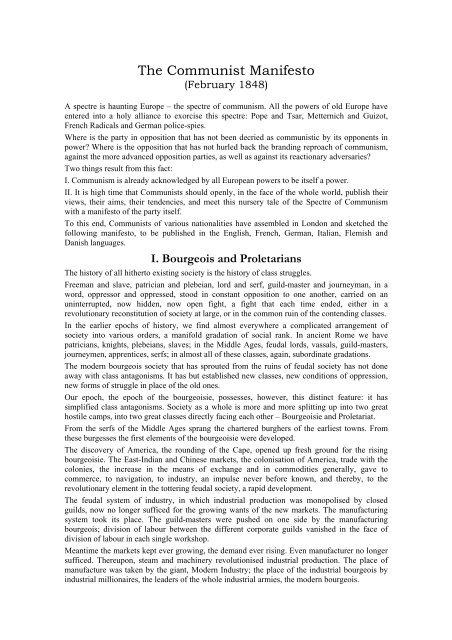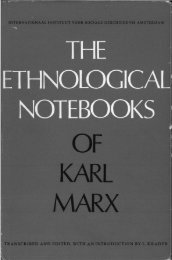The Communist Manifesto
The Communist Manifesto
The Communist Manifesto
Create successful ePaper yourself
Turn your PDF publications into a flip-book with our unique Google optimized e-Paper software.
<strong>The</strong> <strong>Communist</strong> <strong>Manifesto</strong>(February 1848)A spectre is haunting Europe – the spectre of communism. All the powers of old Europe haveentered into a holy alliance to exorcise this spectre: Pope and Tsar, Metternich and Guizot,French Radicals and German police-spies.Where is the party in opposition that has not been decried as communistic by its opponents inpower? Where is the opposition that has not hurled back the branding reproach of communism,against the more advanced opposition parties, as well as against its reactionary adversaries?Two things result from this fact:I. Communism is already acknowledged by all European powers to be itself a power.II. It is high time that <strong>Communist</strong>s should openly, in the face of the whole world, publish theirviews, their aims, their tendencies, and meet this nursery tale of the Spectre of Communismwith a manifesto of the party itself.To this end, <strong>Communist</strong>s of various nationalities have assembled in London and sketched thefollowing manifesto, to be published in the English, French, German, Italian, Flemish andDanish languages.I. Bourgeois and Proletarians<strong>The</strong> history of all hitherto existing society is the history of class struggles.Freeman and slave, patrician and plebeian, lord and serf, guild-master and journeyman, in aword, oppressor and oppressed, stood in constant opposition to one another, carried on anuninterrupted, now hidden, now open fight, a fight that each time ended, either in arevolutionary reconstitution of society at large, or in the common ruin of the contending classes.In the earlier epochs of history, we find almost everywhere a complicated arrangement ofsociety into various orders, a manifold gradation of social rank. In ancient Rome we havepatricians, knights, plebeians, slaves; in the Middle Ages, feudal lords, vassals, guild-masters,journeymen, apprentices, serfs; in almost all of these classes, again, subordinate gradations.<strong>The</strong> modern bourgeois society that has sprouted from the ruins of feudal society has not doneaway with class antagonisms. It has but established new classes, new conditions of oppression,new forms of struggle in place of the old ones.Our epoch, the epoch of the bourgeoisie, possesses, however, this distinct feature: it hassimplified class antagonisms. Society as a whole is more and more splitting up into two greathostile camps, into two great classes directly facing each other – Bourgeoisie and Proletariat.From the serfs of the Middle Ages sprang the chartered burghers of the earliest towns. Fromthese burgesses the first elements of the bourgeoisie were developed.<strong>The</strong> discovery of America, the rounding of the Cape, opened up fresh ground for the risingbourgeoisie. <strong>The</strong> East-Indian and Chinese markets, the colonisation of America, trade with thecolonies, the increase in the means of exchange and in commodities generally, gave tocommerce, to navigation, to industry, an impulse never before known, and thereby, to therevolutionary element in the tottering feudal society, a rapid development.<strong>The</strong> feudal system of industry, in which industrial production was monopolised by closedguilds, now no longer sufficed for the growing wants of the new markets. <strong>The</strong> manufacturingsystem took its place. <strong>The</strong> guild-masters were pushed on one side by the manufacturingbourgeois; division of labour between the different corporate guilds vanished in the face ofdivision of labour in each single workshop.Meantime the markets kept ever growing, the demand ever rising. Even manufacturer no longersufficed. <strong>The</strong>reupon, steam and machinery revolutionised industrial production. <strong>The</strong> place ofmanufacture was taken by the giant, Modern Industry; the place of the industrial bourgeois byindustrial millionaires, the leaders of the whole industrial armies, the modern bourgeois.














![tyf Enf=O=n]lgg](https://img.yumpu.com/47584932/1/190x245/tyf-enfonlgg.jpg?quality=85)

